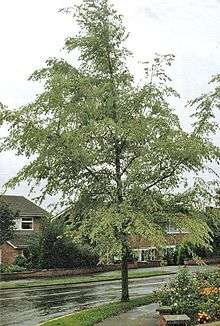Ulmus minor 'Viminalis Pulverulenta'
The Field Elm cultivar Ulmus minor 'Viminalis Pulverulenta' (:'powdery'), also known as 'Viminalis Variegata',[1] a variegated form of U. minor 'Viminalis',[2][3] was first mentioned by Dieck, (Zöschen, Germany) in 1885 as U. scabra viminalis pulverulenta Hort., but without description.[4] Nursery, arboretum, and herbarium specimens confirm that this cultivar was sometimes regarded as synonymous with U. minor 'Viminalis Marginata' (see Cultivation), first listed in 1864, which is variegated mostly on the leaf margin. It is likely, however, that 'Pulverulenta' was the U. 'Viminalis Variegata', Variegated Twiggy-branched elm, that was listed and described by John Frederick Wood, F.H.S., in The Midland Florist and Suburban Horticulturist 1847 and 1851, pre-dating both Kirchner and Dieck.[2][3] Wood did not specify the nature of the variegation.
| Ulmus minor 'Viminalis Pulverulenta' | |
|---|---|
 'Pulverulenta', Bedford, UK. 1991 | |
| Species | Ulmus minor |
| Cultivar | 'Pulverulenta' |
| Origin | Europe |
Description
Dippel (1892) described 'Viminalis Pulverulenta' as having leaves streaked with both white and yellow.[5][6] Wood (1847 and 1851) described 'Viminalis Variegata' as having small leaves and slightly pendulous branches clothed with little shoots, adding that the leaves "occasionally evince a disposition to revert to the green state".[2][3]
.jpg) 'Pulverulenta' at Batsford Arborerum, November 2016
'Pulverulenta' at Batsford Arborerum, November 2016.jpg) Bole of same
Bole of same.jpg) Leaves
Leaves Leaves, June 2014
Leaves, June 2014 Pressed leaves (variegation lost in drying).
Pressed leaves (variegation lost in drying).
Pests and diseases
'Pulverulenta' is very susceptible to Dutch elm disease.
Cultivation
Wood (1847, 1851) considered 'Viminalis Variegata' "a singularly pretty variegated small tree".[2] As a lawn tree, "When grafted standard high it is one of the prettiest trees imaginable for a single specimen".[3] One, listed as U. campestris viminalis variegata, grew in the Royal Victoria Park, Bath, in the mid-19th century.[7] There was a specimen at Kew Gardens in the early 20th century.[8] Three trees were supplied by the Späth nursery of Berlin to the Royal Botanic Garden Edinburgh in 1902 as U. campestris viminalis marginata, shown by herbarium specimens (see 'External links' below) to have been 'Pulverulenta' or 'Variegata'. They may survive in Edinburgh, as it was the practice of the Garden to distribute trees about the city (viz. the Wentworth Elm);[9] the current list of Living Accessions held in the Garden per se does not list the plant.[10] The Ulmus campestris viminalis marginata supplied by Späth and planted in 1897 at the Dominion Arboretum, Ottawa, Canada, is likely also to have been 'Pulverulenta' or 'Variegata'.[11] Ulmus Viminalis variegata, "a variegated variety of good growth", appeared in early 20th-century catalogues of the Gembrook or Nobelius Nursery near Melbourne.[12]
The tree is now extremely rare in cultivation. A specimen that stood in Highnam Court, Gloucestershire, till at least 1969 was labelled 'Viminalis marginata',[13] as is the tree that grows at Batsford Arboretum, Gloucestershire (2017).[14]
Accessions
- Batsford Arboretum, Moreton-in-Marsh, UK. Listed as U. × viminalis 'Marginata', acc. no. 00/952/G2.
Synonymy
- Ulmus montana (: glabra) viminalis gracilis aurea Hort..[15]
- Ulmus scabra (: glabra) viminalis fol. punctatis.[4]
References
- bioportal.naturalis.nl
- Wood, John Frederick (1848). "Trees and shrubs". The Midland Florist and Suburban Horticulturist. London. 2: 227.
- Wood, John Frederick (1852). "Coppiceana". The Midland Florist and Suburban Horticulturist. London. 6: 365.
- Dieck, Georg (1885). Haupt-catalog der Obst- und gehölzbaumschulen des ritterguts Zöschen bei Merseburg. Zöschen. p. 82.
- Green, Peter Shaw (1964). "Registration of cultivar names in Ulmus". Arnoldia. Arnold Arboretum, Harvard University. 24 (6–8): 41–80. Retrieved 16 February 2017.
- Dippel (1892). Illustriertes Handbuch der Laubholzkunde. 2. p. 30.
- Hanham, F. (1857). A Manual for the Park (Royal Victoria Park, Bath). Longman, London.
- Hand-list of trees and shrubs grown in the Arboretum, Kew Gardens (London, 1902), p.617
- Accessions book. Royal Botanic Garden Edinburgh. 1902. pp. 45, 47.
- "List of Living Accessions: Ulmus". Royal Botanic Garden Edinburgh. Retrieved 21 September 2016.
- Saunders, William; Macoun, William Tyrrell (1899). Catalogue of the trees and shrubs in the arboretum and botanic gardens at the central experimental farm (2 ed.). pp. 74–75.
- Gembrook or Nobelius Nursery, Melbourne, 1916 catalogue
- Highnam Court 'Viminalis', bioportal.naturalis.nl
- Johnson, O. (2011). Champion Trees of Britain & Ireland. Kew Publishing, Kew, London. ISBN 9781842464526.
- Beissner, L; Schelle, E; Zabel, H (1903). Handbuch der Laubholz-Benennung. p. 86.
External links
- "Herbarium specimen - L.1582432". Botany catalogues. Naturalis Biodiversity Center. Sheet incorrectly titled viminalis marginata (Highnam Court specimen, Gloucestershire, 1969)
- "Herbarium specimen - WAG.1853169". Botany catalogues. Naturalis Biodiversity Center. Sheet labelled U. viminalis fol. variegata
- "Herbarium specimen - L.1581881". Botany catalogues. Naturalis Biodiversity Center. Sheet labelled U. viminalis variegata (Hillier specimen, Winchester, 1952)
- "Herbarium specimen - E00824794". Herbarium Catalogue. Royal Botanic Garden Edinburgh. Sheet incorrectly labelled U. campestris viminalis marginata, RBGE specimen from Späth nursery, 1902
- "Herbarium specimen - E00824795". Herbarium Catalogue. Royal Botanic Garden Edinburgh. Sheet incorrectly labelled U. campestris viminalis marginata, RBGE specimen from Späth nursery, 1902
- "Herbarium specimen - E00824793". Herbarium Catalogue. Royal Botanic Garden Edinburgh. Sheet labelled U. campestris viminalis variegata
- "Herbarium specimen - E00247719". Herbarium Catalogue. Royal Botanic Garden Edinburgh. Sheet labelled U. viminalis variegata (Specimen from Bath, 1926)